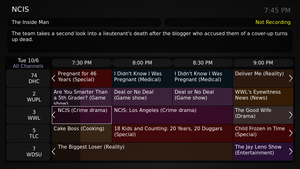Mythbuntu
This article has multiple issues. Please help improve it or discuss these issues on the talk page. (Learn how and when to remove these messages)
No issues specified. Please specify issues, or remove this template. |
 | |
 Mythbuntu showing a program guide/recording scheduler | |
| OS family | Unix-like |
|---|---|
| Working state | Current |
| Source model | Open source |
| Latest release | Mythbuntu 14.04 / April 2014 |
| Package manager | dpkg |
| Kernel type | Monolithic (Linux) |
| Default user interface | Xfce, MythTV |
| Official website | www |
Mythbuntu is a media center operating system (OS). It is based on Ubuntu, integrates the MythTV Media center software as its main function, and does not install with all of the programs included with Ubuntu.
Following the principles of KnoppMyth and Mythdora, Mythbuntu is designed to simplify the installation of MythTV on a home theater PC. After Mythbuntu has been installed the MythTV setup program begins in which it can be configured as a frontend (a media viewer), backend (a media server), or combination of the two.
Mythbuntu aims to keep close ties with Ubuntu thus allowing changes to be moved upstream for the greater benefit of the Ubuntu Community.[1] Due to the close link with Ubuntu, easy conversions between desktop and standalone Mythbuntu installations are possible. The development cycle of Mythbuntu originally followed that of Ubuntu, with releases occurring every six months. Starting with 12.04, Mythbuntu releases track Ubuntu's LTS (long-term support) releases, which release approximately every two years.[2]
Desktop
Mythbuntu uses the Xfce desktop interface by default, but users can install ubuntu-desktop, kubuntu-desktop, or xubuntu-desktop through the Mythbuntu Control Centre, allowing users to get the default interfaces from those flavors of Ubuntu. The only software that is included in this release is media-related software such as VLC, Amunix, and Rhythmbox.
Mythbuntu Control Centre

The Mythbuntu Control Centre provides a GUI which can be used to configure the system. The user can select what kind of system (Backend, Frontend, Both) they wish to have installed. Inside the Control Centre, the user can perform common actions such as installing plugins for MythTV, configuring the MySQL database, setting passwords, and installing drivers and codecs. MythTV updates can be enabled here as well as switching to the latest release version or development branch of MythTV. Configuration of remote controls and a range of other utilities and small programs are performed all from within this program.
Different Applications of Mythbuntu
Complete Installation (Front End and Back End)
Mythbuntu can be used to install a full MythTV system on a single device (acting as both a client and a server). The front end is the software required for the visual elements (or the GUI) and is utilised by the common user to find, play, and manipulate media files. The back end is the server where the media files, tuners, and database are actually stored. A combined front-and-back-end system may have an advantage in that it has portability: it is a standalone device that is not dependent on a separate server, such as a gaming console.
Front-end-only installations

Alternatively, Mythbuntu can be used to install a MythTV client: a front-end-only system. This might be useful where users already have a central storage server in their home. The central storage device can act as a MythTV server, and the MythTV front-end client software can be installed on devices with low-power hardware. Mythbuntu can also run directly from a CD-ROM (without installation), provided that there is a network connection to a PC with a MythTV back-end server.
Using a server separate from one or more front-end units offers the ability to use multiple clients with simultaneous access to a single repository of shared media files. The server used would generally have hardware of a relatively high specification and can be kept outside of the main living room or other entertainment area of the home. Another advantage is the ability to move some of the potentially noisy hardware out of the living room, as low-noise, high-performance hardware can be expensive.
Adding Mythbuntu to Ubuntu
Mythbuntu is an Ubuntu derivative that offers an easy single-click conversion from Ubuntu to Mythbuntu.[1][3] This means a user no longer needs to type in command line, which can be daunting to new users, or hunt for packages in the various package managers.
Version history
- Mythbuntu 7.10 Gutsy Gibbon (with MythTV .20) was released on Monday, October 22, 2007.[4]
- Mythbuntu 8.04 Hardy Heron (with MythTV .21) was released Thursday, Apr 24, 2008.[5]
- Mythbuntu 8.10 Intrepid Ibex (with MythTV .21) was released on Thursday Oct 30th, 2008.[6]
- Mythbuntu 9.04 Jaunty Jackalope (with MythTV .21-fixes) was released on Thursday April 23, 2009.[7]
- Mythbuntu 9.10 Karmic Koala (with MythTV .22) was released on Thursday October 29, 2009.[8]
- Mythbuntu 10.04 Lucid Lynx (with MythTV .23) was released on Thursday April 29, 2010.[9]
- Mythbuntu 10.10 Maverick Meerkat (with MythTV .23.1) was released on October 19, 2010.[10]
- Mythbuntu 11.04 Natty Narwhal (with MythTV .24) was released on April 28, 2011.[11]
- Mythbuntu 11.10 Oneiric Ocelot (with MythTV .24) was released on October 13, 2011.[12]
- Mythbuntu 12.04 Precise Pangolin (with MythTV .25) was released on April 26, 2012.[13]
- Mythbuntu 12.04.1 Precise Pangolin (with MythTV .25-fixes) was released on November 21, 2012.[14]
- Mythbuntu 12.04.2 Precise Pangolin (with MythTV .25.2-fixes) was released on February 14, 2013.[15]
- Mythbuntu 12.04.3 Precise Pangolin (with MythTV .25.2-fixes) was released on September 6, 2013.[16]
- Mythbuntu 14.04 Trusty Tahr (with MythTV .27) was released on April 17, 2014.[17]
See also
References
- ^ a b "Installing Mythbuntu packages within Ubuntu".
- ^ "Mythbuntu LTS".
- ^ "Install link target".
- ^ http://www.mythbuntu.org/7.10/release
- ^ http://www.mythbuntu.org/8.04/release
- ^ http://www.mythbuntu.org/8.10/release
- ^ http://www.mythbuntu.org/9.04/release
- ^ http://www.mythbuntu.org/downloads
- ^ http://www.mythbuntu.org/10.04/release
- ^ http://www.mythbuntu.org/10.10/release
- ^ http://www.mythbuntu.org/11.04/release
- ^ http://www.mythbuntu.org/11.10/release
- ^ http://www.mythbuntu.org/12.04/release
- ^ http://www.mythbuntu.org/home/news/12041released
- ^ http://www.mythbuntu.org/home/news/12042released
- ^ http://www.mythbuntu.org/home/news/12043released
- ^ https://sites.google.com/a/mythbuntu.org/website/home/news/mythbuntu1404releasedbetterlatethanneveredition

